As you read this, people are boarding planes, trains, or taxicabs to visit your destination. Why are they travelling? How did they plan the trip? What experiences await them? How will they relive the adventure? What stories will they tell, good or bad, and to whom?
These questions describe the customer journey. Your destination marketing organization (DMO) has a role in this journey from beginning to end that includes helping people dream and plan their trip, delivering the experiences that make people happy and doing so in a way that builds advocates for your destination. Transformative travel experiences lead to positive stories told online and offline. These stories inspire new visitors, who plan new trips and board the next flight.
It’s a virtuous cycle when managed well. Tourism experiences and word-of-mouth reinforce one another to drive business and, ultimately, improve your destination’s quality of life.
What does it look like for a DMO to help visitors at each stage of their trip? Here’s how Destination Think’s team in Campbell River, Canada does it online, with examples and tips from every stage of the journey.
Destination Campbell River’s customer journey through social media

Carly Pereboom, Destination Marketing Specialist at Destination Campbell River
Campbell River is immersed in nature. The small Vancouver Island, Canada city is particularly known to visitors as a great fishing spot, but that only begins to describe what it offers as a tourism destination.
The team at Destination Campbell River (DCR) is primed to help visitors through the customer journey at every stage. In 2017, Destination Think began providing full-service destination management for the city. Carly Pereboom, Destination Marketing Specialist and Tamasyn Kennedy, Visitor Engagement Coordinator, have been with our DCR team since the beginning. These two skilled destination marketers work side-by-side to help people find the experiences they want most from the region. Among other responsibilities, their roles include working together on the destination’s social media presence and visitor servicing. They’re passionate about fostering community pride and sharing visitor stories to encourage travel – often with an educational and humorous twist.

Tamasyn Kennedy, Visitor Engagement Coordinator at Destination Campbell River
Here’s how Carly and Tamasyn add value to the customer journey every step of the way through social media.
Stage 1: Awareness
Your DMO is only one source of stories among thousands or millions about your destination. Often, your organization can step out of the spotlight to let others take the stage, as this example shows.
“These two images are a great example of influencer work that just keeps giving,” says Carly. “Advocacy and awareness about our destination are happening on channels other than ours; we make sure we’re responding and continuing the conversation.”
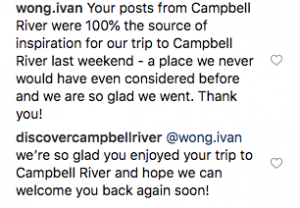 The @vancitywild Instagram account posted this second, similar image almost a year later, tagging the location and generating even more engagement than the first post.
The @vancitywild Instagram account posted this second, similar image almost a year later, tagging the location and generating even more engagement than the first post.
Tip: When relevant, use your DMO’s social media channels to engage with comments on other channels, whether they belong to media organizations, your tourism operators or partner destinations.
Stage 2: Consideration
Greater awareness of your destination brings opportunities to speak to new audiences. In this stage, you can inspire people to explore more of what the destination can offer.
This post reached an audience of passionate divers. Some of them tagged one another in the comments, while others left many positive comments about diving.
The visitor testimonial below also proved engaging. Through posts like these, Carly and her team sparked conversation about lesser-known experiences. “It provides inspiration to explore no matter what time of year while creating awareness about the varying activities that are possible year round,” she says.
Tip: When you plan your posts, get specific about the activity you share and why someone would be interested enough to respond. How are you helping them have a better experience?
Stage 3: Intent
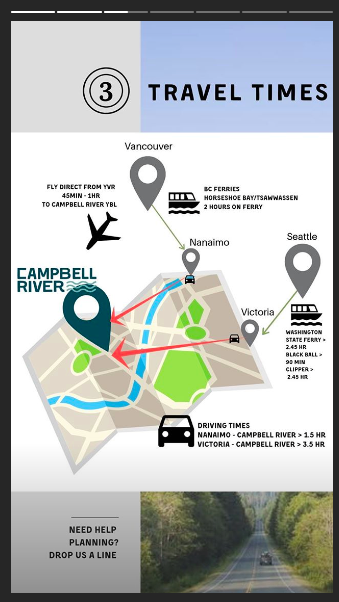
Your DMO can shine in this stage, which is all about education. On social media, helping people plan their trips means giving them itineraries, places to stay, things to do, how to get there – anything your visitors need to have the best experience possible.
Many visitors drive to Campbell River, so the team uses Instagram Stories to create and save highlights like “Getting Here” that help people plan a road trip.
Other posts support by providing facts like driving times from common starting points.
The DCR team shares potential itineraries and travel information through blog posts. This post describes a short but satisfying road trip. “The comments are full of people adding the idea to their lists and tagging their friends,” says Carly. “Best of all, it’s part of our #MeetTheNeighbours messaging (one result of Campbell River’s brand strategy), which supports regional partners and works to bring awareness to areas that are overlooked, dispersing people throughout the region during high traffic periods.”
Tip: You can draw more people into your destination’s network by both sharing blog posts through social media and embedding social posts into blog articles.
Stage 4: Purchase
Your DMO’s primary role is to generate demand rather than to complete bookings. As coordinator of your destination’s tourism operators, though, your opportunity is to generate leads for stakeholders.
In this post, the Campbell River team supported a partner’s product launch as that company worked to build awareness of a new helicopter tour. “The stunning imagery in this post inspired many people and even prompted one user to contact the company and purchase the trip,” says Tamasyn.
Tip: Support your tourism operators online by sharing their stories and tagging them in posts.
Stage 5: Visit
Your visitors have arrived. How can you make their experiences the best they can be?
In Campbell River, “online assistance and in-person recommendations go hand-in-hand to deliver a stellar visitor experience,” Carly says. “Once they’re in the destination, we have the opportunity to create an advocate for life.”
People are talking about your destination online, and some of them will reach out via social media. To help even more visitors, you’ll need to do some active listening. The Campbell River visitor servicing and social media teams compare notes to make sure they’re addressing needs.
“Our front-line servicing influences our social content, providing us insights about the travel journey, such as when to start changing seasonal messaging and when to talk about pre-booking and planning for the high season,” says Tamasyn. “Advance planning is key to ensuring that visitors can enjoy the variety of wildlife, bears, whales, eagles, etc., and also have a wonderful place to sleep.”
Tip: Find opportunities to build advocates for life by listening and responding through online channels. Sometimes a little extra effort goes a long way.
Stage 6: Relive
All great vacations must end. But the stories never stop.
After positive and memorable experiences, visitors often relive their trips by telling friends and family. The urge to tell a good travel story helps people connect, but it also builds valuable advocacy for the destination. Word of mouth has an enormous influence on travel decisions. To encourage this, our team in Campbell River amplifies some of the best visitor stories. Visitors are becoming Campbell River’s most effective marketers.
Destination Campbell River shared this visitor’s tale of a winter hike:
“Dena actually wrote to us and let us know how much she had enjoyed her experience. We loved her words so much we decided to use them as a post,” Tamasyn says.
Stories like these help make others aware of the best experiences, giving people the chance to make memories and tell their own stories.
Tip: Remember that your visitors and residents are your destination’s best marketers. Amplify their stories to increase word-of-mouth promotion.
Which brings us full circle, all the way back to awareness.
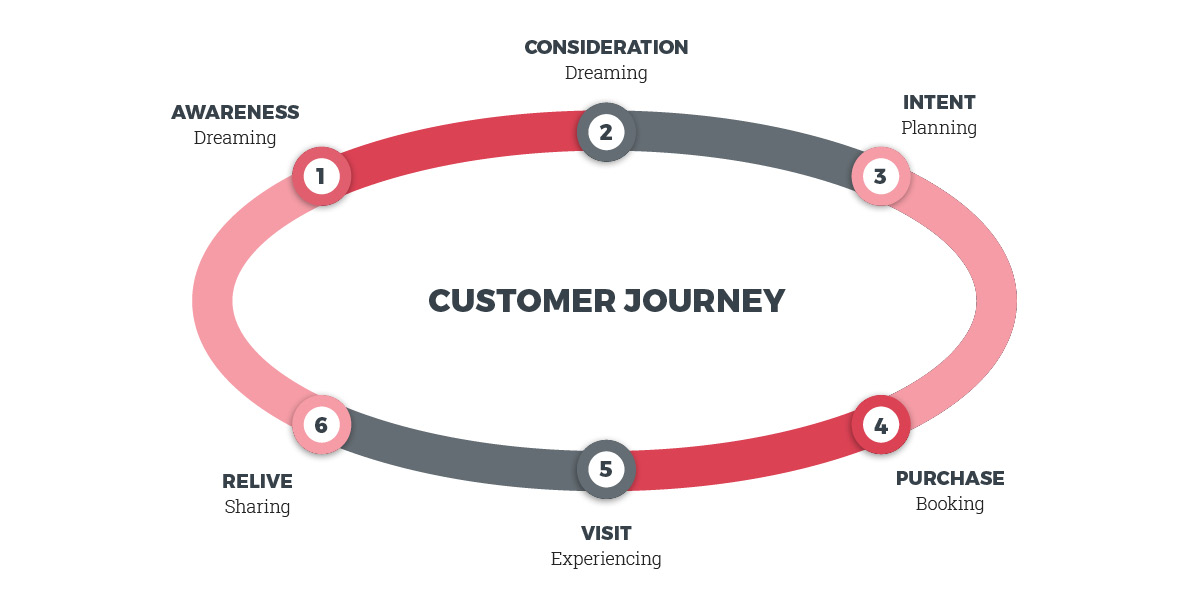
Destination Campbell River’s focus on visitor needs comes from its home-grown strategy
This focus on visitor needs didn’t happen by accident. Campbell River’s foundational tourism strategy is an expression of Campbell River’s identity, which comes directly from its people.
Destination Think used our Place DNA® process to collaborate with the city’s residents and tourism operators to articulate precisely what makes this place distinct. The result has shaped everything from Campbell River’s place brand to its destination marketing plans, to Destination Campbell River’s social media strategies and tactics.
“On social media, a big part of our strategy is to express our vibrant community personality, to be friendly, to provide a space for people to share and interact with one another, and to get to know our brand. We’re accessible and always willing to respond, help and assist with travel plans,” Carly says, “We’re like those web bots that pop up and ask if you need help, but better.”
That’s an understatement. No bot could manage visitor engagement and emulate the level of empathy, sense of humour, sparkling personality and sheer human-to-human helpfulness that the Destination Campbell River team provides for travellers, day in and day out.
This empathic style of management bodes well for the destination and points to new opportunities for DMOs. After all, tourism advocacy happens through relationships and storytelling – distinctly human activities. Traditional advertising, which tends to focus on the early stages of the customer journey, is not the most effective way to build advocacy and word of mouth. Instead of spending money on attention and mass awareness, your DMO will benefit most by managing the destination and its stories from the start of the customer journey to its finish.




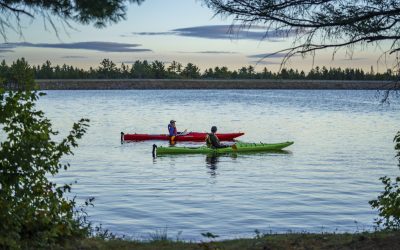
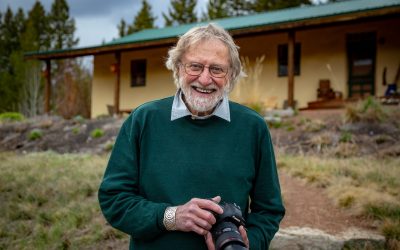




0 Comments